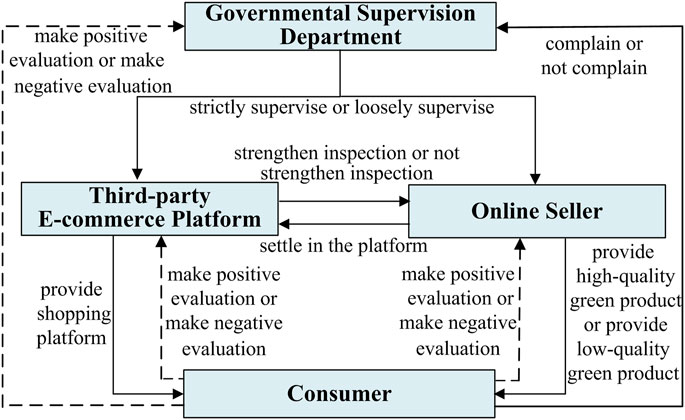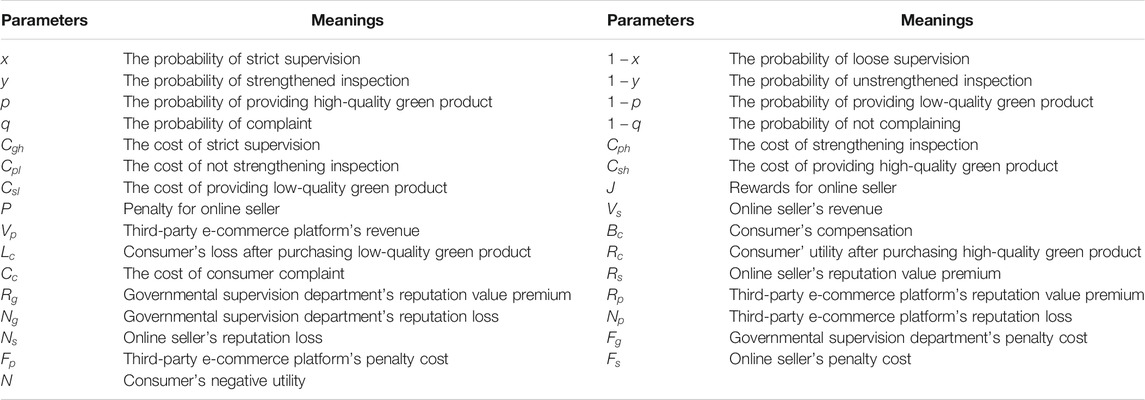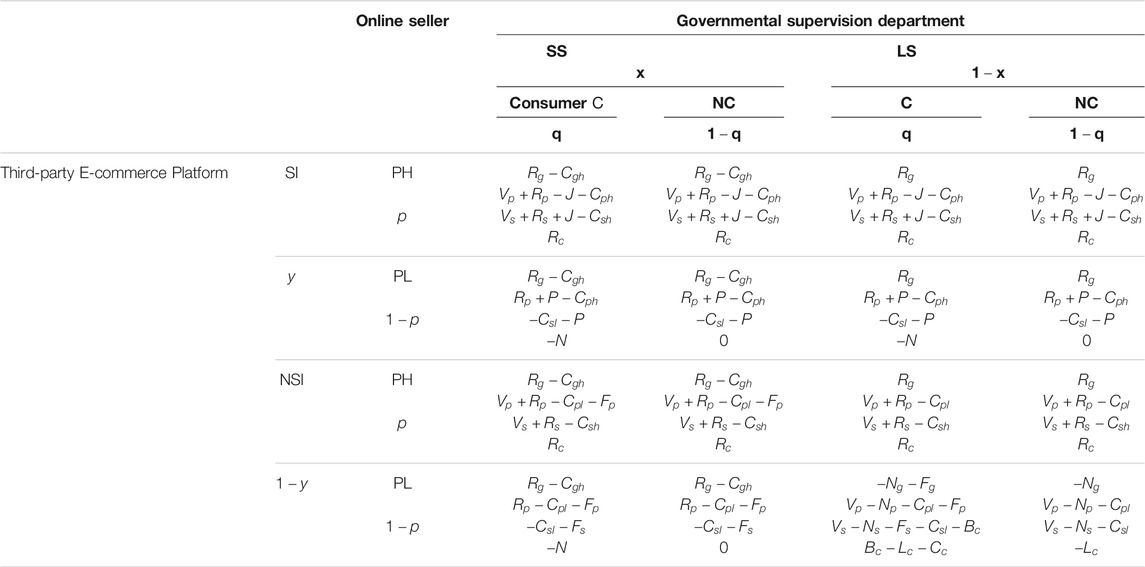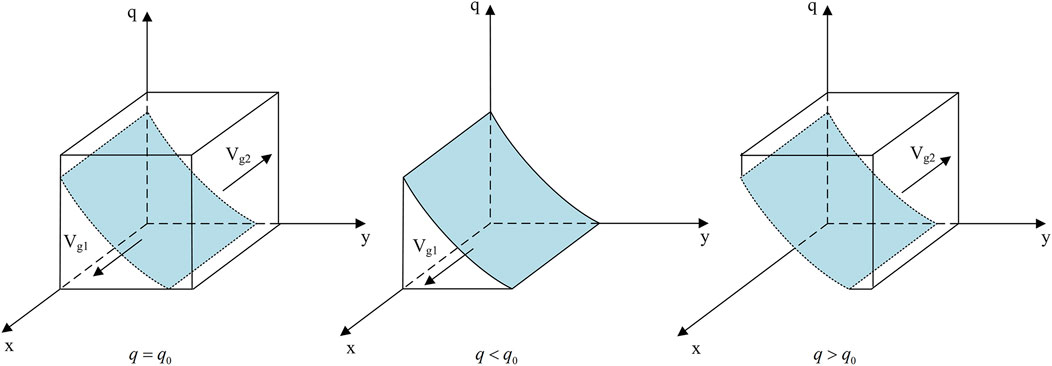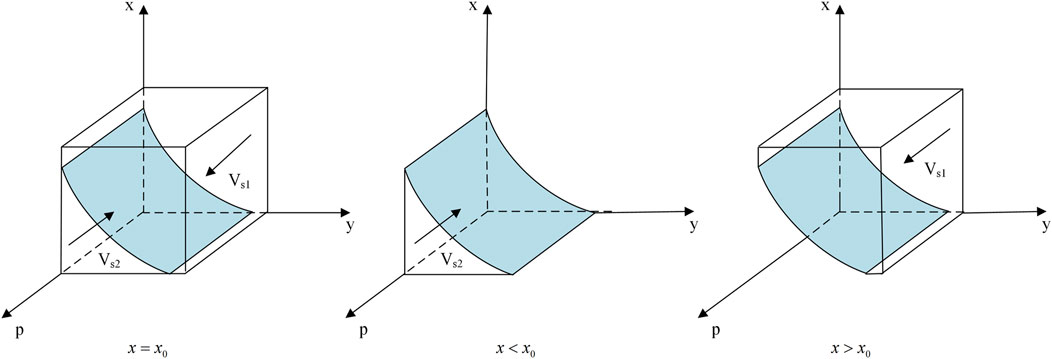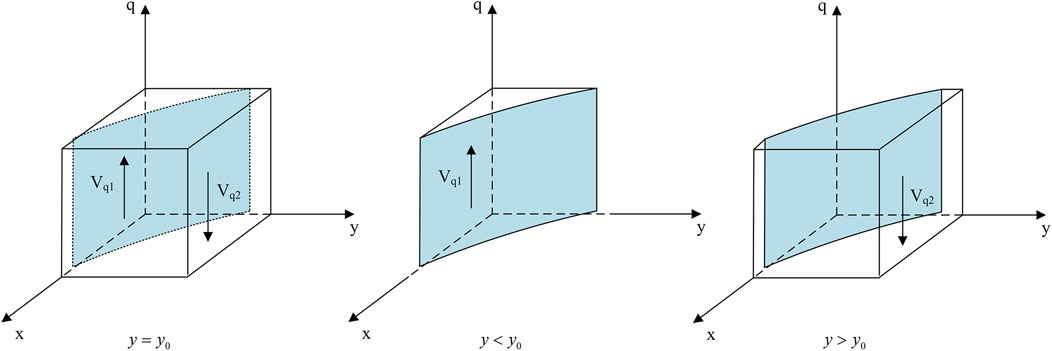- 1School of Business, Shandong Normal University, Ji’nan, China
- 2Quality Research Center, Shandong Normal University, Ji’nan, China
Green consumption is an important foundation for achieving stable and long-term economic development goals. With the rapid development of e-commerce and people’s widespread attention to sustainability, more and more consumers purchase green products online. Therefore, we consider consumer feedback mechanisms including evaluation and complaint and construct an evolutionary game model of green product quality supervision with the participation of governmental supervision department, third-party e-commerce platform, online seller and consumer, which analyzes the four parties’ evolutionary stable strategies. To verify the theoretical results, we conduct a numerical simulation by Matlab 2020b. Moreover, we study the conditions that make evolutionary stable strategy combination exist based on Lyapunov’s First Method. And we find that when consumer chooses complaint, (0, 0, 1) is likely to become an only evolutionary stable strategy combination. At this time, the online seller chooses to provide high-quality green product, third-party e-commerce platform chooses not to strengthen inspection, and governmental supervision department chooses to strictly supervise. Conversely, when the consumer chooses no complaint, (1, 0, 0) and (0, 0, 1) may become an evolutionary stable strategy combination. At this time, the online seller cannot be stable in providing high-quality green product. What’s more, governmental supervision department increases the penalty, which can incentivize a third-party e-commerce platform to strengthen inspection. Third-party e-commerce platform increases the reward and can promote online seller to provide high-quality green product. On the one hand, this paper enriches the theoretical basis of online shopping green product quality supervision. On the other hand, compared with existing literature, it extends the main body of the evolutionary game to four paries and broadens the application scope of the game model. In addition, it has put forward feasible suggestions for the government supervision department to strengthen the quality supervision, and provided decision-making support for the third-party e-commerce platform to assume the responsibility of quality inspection.
Introduction
The growth of e-commerce is transforming shopping consumption from offline to online. According to Global E-commerce Data Report, online retail transactions of China, the United States, the United Kingdom, and Japan were 1,309.5 billion dollars, 520 billion dollars, 291 billion dollars, and 179 billion dollars in 2019, with growth rates of 25.5, 15.8, 11.1, and 19.1%, respectively. The prosperous development of online shopping provides a broad platform for green products. Green product refers to what meets specific environmental protection requirements during the entire process of production, processing, transportation, consumption, and recycling, and has the lowest harm to the ecological environment, the highest resource utilization, and the least energy consumption. Online shopping green product not only brings great convenience but also satisfies consumers’ demands for environmental protection. Consumers are paying more and more attention to green product quality. However, there are some serious problems, such as the lack of government supervision, insufficient inspection of third-party e-commerce platform, irregularities in green product certification standards, illegal sales of online seller, and invalid complaint of consumers.
In some countries, such as China, the United States, the United Kingdom, and Japan, many corresponding measures have been taken. China began to implement the e-commerce law in 2019, which clarified the issues of counterfeit sales and consumer rights protection. The United States has established a across-departmental e-commerce management agency and government e-commerce working group, implemented strict unreasonable return system, and also built the Better Business Bureau for consumer complaint and rights protection. The United Kingdom has established a special office which is responsible for monitoring whether companies have reached the relevant standards of product and service, and implemented some laws and regulations, such as the E-commerce Regulations and the United Kingdom Consumer Protection Act, which have provided a basis for the e-commerce supervision. Japanese e-commerce started late, but its development speed is rapid. The Japanese government has formulated a series of laws and regulations, such as Electronic Consumer Contract Law, Resolution Framework for Consumer Disputes in Electronic Commerce, which intensify the supervision of e-commerce transactions. Despite many countries having made great efforts, online shopping green product quality problems have not been solved. There is a need to further study how to achieve effective supervision.
More and more practice show that consumer feedback is becoming increasingly important in online shopping, and product quality problems need to be solved by multiple parties (Li et al., 2015). Therefore, this paper considers a consumer feedback mechanism including evaluation and complaint and constructs an evolutionary game model with the participation of governmental supervision department, third-party e-commerce platform, online seller, and consumer. We analyze each party’s evolutionary stable strategy and factors’ influence on four parties’ strategic choices. Based on the Lyapunov’s First Method (Liu et al., 2015), we study the conditions that make evolutionary stable strategy combination exist, and verify our theoretical analysis results with numerical simulation by Matlab 2020b. This paper aims to solve the following questions: How does consumer evaluation and complaint influence each party’s strategic choice? How does a third-party e-commerce platform design reasonable reward and penalty to incentivize the online seller to provide high-quality green products? How does a governmental supervision department make effective supervision strategies to improve online shopping green product quality?
The rest of our paper is organized as follows. In Literature Review, we review relevant research on online shopping green product quality. We make assumptions and construct an evolutionary game model in Model Assumptions and Construction. In The Stability Analysis of Strategic Choices, each party’s strategy stability is analyzed. In Stability Analysis of Strategy Combination, we analyze the strategy combination’s stability based on the Lyapunov’s First Method. In Numerical Simulation Analysis, we conduct numerical simulation by Matlab 2020b, which analyzes factors’ influence on the evolutionary stable strategy combination. At last, suggestions and advices are provided in Summary. Throughout the paper, from the abstract, introduction, literature review, method, to the final conclusion, we refer to some excellent references to improve the study (Abbas et al., 2019; Aman et al., 2019; Mubeen et al., 2020; Abbasi et al., 2021).
Literature Review
Online Shopping Product Quality
As we know, the spread of COVID-19 creates disruption, uncertainty, complexity, and ambiguity in all walks of life (Azizi et al., 2021). People’s demand for online shopping has greatly increased. However, product quality is also worrying. The serious information asymmetry between consumer and online seller is the root cause of online shopping product quality problems. Information about product quality will affect consumers’ purchase intention (Zhou et al., 2018), and the consumer usually makes assessment through the information about product quality provided by a third-party e-commerce platform and online seller (Mavlanova et al., 2012). For the online seller, disclosing the transaction data timely makes it easier to attract customers (Subramanian and Rao, 2016). Correct information is indispensable to dispel uncertainty (Abbas et al., 2021). Information sharing helps companies become more dynamic, innovative, and competitive (Abbas et al., 2019). Competitive online sellers tend to disclose as much product information as possible (Tao et al., 2018). Low-quality online sellers, however, may use the information transmission mechanism to pretend to be a high-quality seller and sell low-quality product (Fouliras, 2013), which leads to increasingly serious online shopping product quality problems. As consumers’ awareness of rights protection increases, the return rate has gradually increased, resulting in the increasing cost of stakeholders’ return management (Shang et al., 2017). Therefore, a third e-commerce platform has the motivation to strengthen inspection of online seller’s qualification and provide the consumer with reliable information (Loureiro et al., 2012). But actually, in order to pursue higher profits, the collusion between third-party e-commerce platform and online seller usually occurs (Park and Ju, 2016).
Online shopping product problems are very common in many countries, which have aroused many researchers’ attention. They have proposed various mechanisms such as supervision mechanism (Li et al., 2018), revenue sharing mechanism (Zhang et al., 2019), return management system (Griffis et al., 2012; Seung, 2014), supply chain management system (Kaynak and Hartley, 2008; Zhu, 2020), reward and penalty system (He and Zhu, 2020). Scholars usually conduct research from a single party perspective. But in fact, the product quality problems involve multiple parties. Therefore, this paper constructs an evolutionary game model involving four parties.
Green Product
In the late 1980s and early 1990s, the term of green was created in the marketing field (Wang et al., 2020). With the progress of society, balancing the relationship between economic development and environmental protection has become a hot topic (Bai et al., 2020). Correspondingly, green and sustainability are considered to be particularly common in production, consumption, and other fields. From the perspective of the consumer, the consumer pays more attention to sustainability and environmental protection and prefers to buy green products (Hong and Guo, 2019). However, green product quality still falls short of consumers’ expectations. From the perspective of the seller, compared with non-green product, green product does have moral advantages while it has disadvantages in price (Dixon and Mikolon., 2020). The R&D, production, sales, recycling, and other links of green product all require higher costs, which may discourage producer and seller from improving product quality. From the perspective of government, government usually provides higher subsidies and lower taxes to producer and seller (Sana, 2020). And the continuous improvement of green standards also can improve a green product’s environmental benefits (Gao et al., 2020). Strict enforcement of regulations by government in practice is an effective incentive measure. What needs to be paid attention to is that government should implement regulations carefully, because overly strict regulations may cause producer and seller to be reluctant to innovate, and gain higher profits at the cost of reducing overall environmental performance (Maryam and Hossein, 2018). Market competition can stimulate producer and seller to make choices that meet public requirements (Guo et al., 2019). It can be seen that most of the existing researches study product quality supervision, but are less involved in green product quality supervision, so this paper analyzes how to supervise green product quality in online shopping.
Consumer Evaluation
Positive evaluation is usually related to the product itself (Ahmad and Laroche, 2016), and negative evaluation has a great impact on management and service quality (Chevalier et al., 2018). Effective social evaluation can reduce consumer losses (Zheng et al., 2019). The more serious the information asymmetry, the more online evaluation can reduce the uncertainty of product quality (Zhang et al., 2017). The consumer’s perception of product quality will be delayed due to information asymmetry (Li et al., 2018), but online evaluation can help consumers get some product quality information in advance, thereby reducing risk and uncertainty (Yang et al., 2016). Therefore, consumers are more inclined to trust online evaluation than information provided by third-party e-commerce platform and online seller. In addition, online evaluation is not only valuable for consumers to make purchasing decisions (Fu et al., 2018) but also helpful for the online seller to attract consumers (Siering et al., 2018), because customer’s trust can significantly affect the seller’s commercial reputation (Song et al., 2019). The above research simply focus on the importance of consumer evaluation in online shopping but does not consider consumer complaint. This paper considers both consumer evaluation and complaint, and more comprehensively analyzes the role of consumer in online shopping green product quality supervision.
Generally, although some empirical research has analyzed the quality supervision of the online shopping green product, there still lacks an appropriate mathematical model to study each party’s stable strategy. Additionally, there are few studies involving multiple parties and considering consumer feedback mechanism.
Therefore, this paper considers consumer feedback mechanism and constructs a four-party evolutionary game model, which analyzes four parties’ evolutionary stable strategies, studies the conditions that make evolutionary stable strategy combination exist based on the Lyapunov’s First Method, and verifies theoretical analysis results with numerical simulation by Matlab 2020b.
Model Assumptions and Construction
This paper constructs a four-party evolutionary game model. The structure relationship of green product quality supervision in online shopping is shown in Figure 1.
Model Assumption
The four parties are governmental supervision department, third-party e-commerce platform, online seller, and consumer. Governmental supervision department’s strategic choice space is {SS, LS}, i.e., {Strictly Supervise, Loosely Supervise}. Third-party e-commerce platform’s strategic choice space is {SI, NSI}, i.e., {Strengthen Inspection, Not Strengthen Inspection}. Online seller’s strategic choice space is {PH, PL}, i.e., {Provide High-quality Green Product, Provide Low-quality Green Product}. Consumer’s strategic choice space is {C, NC}, i.e., {Complain, Not Complain}.
Governmental supervision department chooses to strictly supervise with the probability of
Governmental supervision department’s cost of strict supervision is
When a green product is sold, online seller’s revenue is
When the online seller provides a low-quality green product, the third-party e-commerce platform does not strengthen inspection, and the governmental supervision department chooses loose supervision, the low-quality green product will enter the market, and the consumer will undertake the loss
When the online seller provides a low-quality green product, the third-party e-commerce platform strengthens inspection or governmental supervision department strictly supervise, a low-quality green product is prohibited from entering the market, and the consumer’s purchasing needs have not been met, the consumer’s negative utility is
The parameters setting and their meanings are shown in Table 1.
Model Construction
This paper considers a consumer feedback mechanism including evaluation and complaint, and constructs an evolutionary game model. The mixed game matrix for green product quality supervision in online shopping is shown in Table 2.
The Stability Analysis of Strategic Choices
The Stability Analysis of Governmental Supervision Department Strategic Choices
The expected profit when governmental supervision department chooses strictly supervision is
According to the stability theorem of differential equations, the probability of SS in a stable state must satisfy
Proposition 1When
Corollary 1.1The higher the reputation value premium brought by the consumer’s positive evaluation, the higher the probability that governmental supervision department chooses the SS strategy.Proof Take the first- order derivative of
Corollary 1.2With the increasing of strict supervision cost, the probability that governmental supervision department chooses the SS strategy will decrease.Proof Take the first-order derivative of
The Stability Analysis of Third-Party e-Commerce Platform Strategic Choices
The expected profit when a third-party e-commerce platform chooses to strengthen inspection is
According to the stability theorem of differential equations, the probability of SI in a stable state must satisfy
Proposition 2When
Corollary 2.1With the increasing of the reputation value premium brought by the consumer’s positive evaluation or the reputation loss brought by the consumer’s negative evaluation, the probability that a third-party e-commerce platform chooses the SI strategy will increase.Proof Take the first-order derivative of
Corollary 2.2Governmental supervision department increases the penalty can encourage third-party e-commerce platform to choose the SI strategy. Proof Take the first-order derivative of
The Stability Analysis of Online Seller Strategic Choices
The expected profit when an online seller chooses to provide high-quality green products is
According to the stability theorem of differential equations, the probability of PH in a stable state must satisfy
Proposition 3When
Proof Let
Corollary 3.1 With the increasing reward and penalty from a third-party e-commerce platform, the probability that the online seller chooses the PH strategy will increase.Proof Take the first-order derivative of
Corollary 3.2The higher the reputation value premium brought by a consumer’s positive evaluation and the reputation loss brought by a consumer’s negative evaluation, the higher the probability that an online seller chooses the PH strategy.Proof Take the first-order derivative of
Corollary 3.3When the consumer purchased a low-quality green product, the higher compensation, the more an online seller tends to choose the PH strategy.Proof Take the first-order derivative of
The Stability Analysis of Consumer Strategic Choices
The expected profit when a consumer chooses to complain is
According to the stability theorem of differential equations, the probability of C in a stable state must satisfy
Proposition 4When
Corollary 4.1With the increasing of a consumer’s complaint cost, the probability that the consumer will choose the C strategy will decrease.Proof Take the first-order derivative of
Corollary 4.2When consumers purchase a low-quality green product, the higher compensation that consumers get from the online seller, the more consumers tend to choose the C strategy.Proof Take the first-order derivative of
Stability Analysis of Strategy Combination
According to Lyapunov’s First Method, if the Jacobi matrix eigenvalues are negative, the equilibrium solution is an evolutionary stable strategy (ESS); if the Jacobi matrix has one or more positive eigenvalues, the equilibrium solution is an unstable strategy; if the Jacobi matrix eigenvalues are zero or negative, the equilibrium solution’s stability is uncertain. In a multi-party evolutionary game, if the equilibrium solution is an evolutionary stable strategy, the equilibrium solution is strict Nash equilibrium, that is, pure strategy equilibrium (Rong and Zhu, 2020). Therefore, this paper analyzes 16 pure strategy equilibrium solutions’ stability. According to the four parties’ replicator dynamic equations, we can get the following Jacobi matrix.
Stability Analysis When Consumer Chooses Complaint
Consumer’s evolutionary stable strategy is complaint, when
Proposition 5 When consumer chooses complaint, (0, 0, 1) is likely to become an only evolutionary stable strategy combination. At this time, the online seller chooses the PH strategy, third-party e-commerce platform chooses the NSI strategy, and the governmental supervision department chooses the LS strategy. Proof According to the Lyapunov’s First Method, when consumer chooses complaint, if condition
Stability Analysis When Consumer Chooses No Complaint
Consumer chooses no complaint, when
Proposition 6 When a consumer chooses no complaint, (1, 0, 0) and (0, 0, 1) may become an evolutionary stable strategy combination. Proof According to Lyapunov’s First Method, when a consumer chooses no complaint, if conditions
Numerical Simulation Analysis
In this paper, we conduct numerical simulation by Matlab 2020b, which analyzes each factor how to influence the four parties’ strategic choices. When assigning values to the parameters, we refer to the literature in some excellent journals and some statistics report data. According to consumer complaints, the China Consumers Association recovered a total of CNY 1.177 billion economic losses for consumers in 2019, and complaints about product quality problems accounted for 25.13% of all complaints. Therefore, this paper sets consumers’ compensation
The Impact of Reputation Value Premium and Reputation Loss
Let
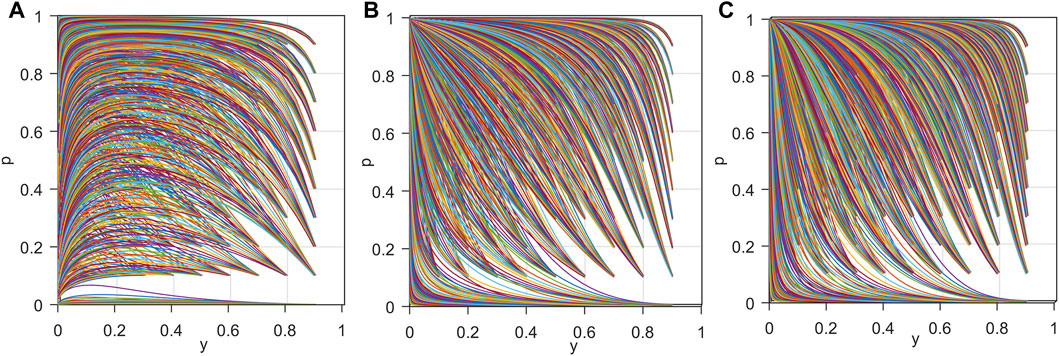
FIGURE 6. The impact of reputation value premium and reputation loss. (A) when the situation is (0, 0). (B) when the situation is (4, 3). (C) when the situation is (8, 6).
As can be seen from Figure 6A, when the reputation value premium or reputation loss brought by consumer evaluation are small, the stable point is (0,0). The online seller is stable in providing a low-quality green product, and a third-party e-commerce platform is stable in not strengthening inspection. But, with the increasing of reputation value premium or reputation loss, the greater the influence on the online seller and third-party e-commerce platform, the stable point turns into (0,1). The online seller’s evolutionary stable strategy is to provide high-quality green product, and a third-party e-commerce platform’s evolutionary stable strategy is not to strengthen inspection (Figures 6B,C). We can get that the increase in reputation value premium or reputation loss can promote the online seller to provide a high-quality green product.
The Impact of Reward and Penalty
Let

FIGURE 7. The impact of reward and penalty. (A) when the situation is (0, 0). (B) when the situation is (30, 30). (C) when the situation is (60, 60).
As can be seen from Figure 7A, when an online seller’s reward and penalty from third-party e-commerce platform is zero, it means that the third-party e-commerce platform has chosen not to strengthen inspection. At this time,
The Impact of Consumer Complaint
Let
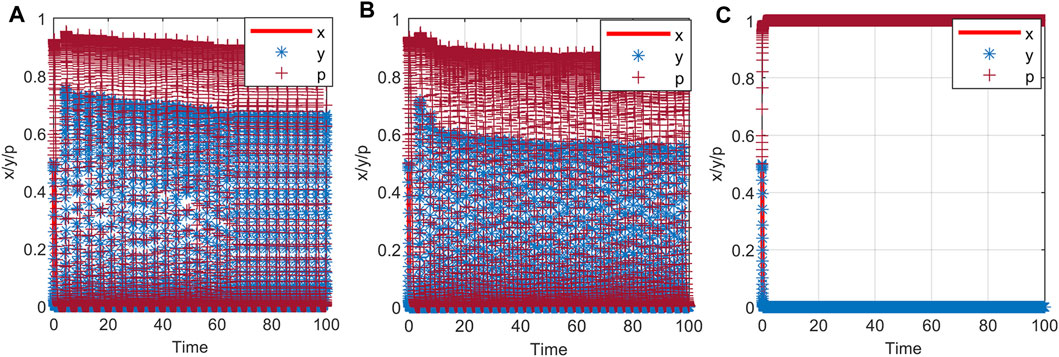
FIGURE 8. The impact of consumer complaint. (A) when the situation is (0). (B) when the situation is (0.5). (C) when the situation is (1).
As can be seen from Figure 8, when the probability that a consumer chooses complaint is low (Figure 8A), there is no evolutionary stable strategy. With the increasing of the probability that a consumer chooses complaint, the strategic choices of online seller and third-party e-commerce platform fluctuates (Figure 8B). When a consumer’s strategic choice has gradually stabilized to choose complaint, the online seller will provide high-quality green products, and the third-party e-commerce platform will stabilize to not strengthen inspection (Figure 8C). Therefore, the consumer should raise rights protection awareness and actively complain about the online seller’s illegal behavior.
The Impact of Penalty Cost
Let
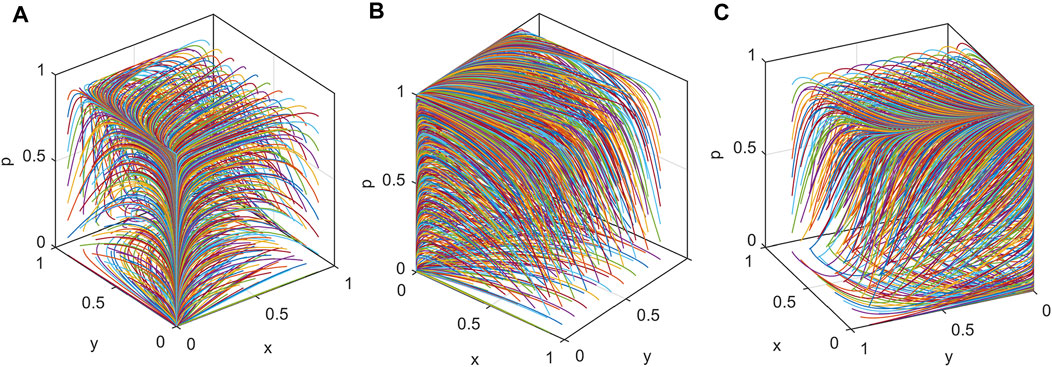
FIGURE 9. The impact of penalty cost. (A) when the situation is (6, 4.61, 2). (B) when the situation is (12, 10.61, 8). (C) when the situation is (18, 16.61, 14).
As can be seen from Figure 9, when the penalty cost is low, the stable point is (0,0,0), governmental supervision department chooses to loosely supervise, third-party e-commerce platform chooses to strengthen inspection, and online seller chooses to provide low-quality green product (Figures 9A,B). With the increasing of the penalty cost, the stable point turns into (0,0,1), governmental supervision department has stabilized to loosely supervise, the third-party e-commerce platform has stabilized to not strengthen inspection, and the online seller has gradually stabilized to provide high-quality green product. Therefore, a governmental supervision department should increase the penalty to promote that the online seller provide high-quality green product.
Summary
Conclusion and Policy Implications
This study describes that with the rapid e-commerce development, consumers pay more attention to sustainability, and a growing number of consumers prefer to purchase green products online. This paper considers consumer feedback mechanisms including evaluation and complaint and constructs four-party evolutionary game model, which analyzes four parties’ evolutionary stable strategies. Further, it studies the conditions that make evolutionary stable strategy combination exist based on Lyapunov’s First Method. Finally, this paper verifies theoretical analysis results with numerical simulation by Matlab 2020b. The main conclusions are as follows.
The consumer’s evaluation will affect an online seller’s reputation and promote the online seller to provide high-quality green product. When the reputation value premium or reputation loss brought by consumer evaluations are small, the online seller is stable in providing low-quality green product. But, with the increasing of reputation value premium or reputation loss, the online seller’s evolutionary stable strategy will turn into providing a high-quality green product. Therefore, third-party e-commerce platform should implement the reputation rating system based on consumer evaluation, which can be a constraint and incentive for online sellers, because it will directly affect the online seller’s search rankings and promotion positions. And when the online seller provides low-quality green product, the consumer should make a negative evaluation.
Third-party e-commerce platform increases reward and penalty for the online seller can help improve online shopping green product quality. When an online seller’s reward and penalty from third-party e-commerce platform are small, the online seller will provide a low-quality green product. However, with increasing of the reward and penalty, the online seller has gradually stabilized to provide high-quality green product. Therefore, the third-party e-commerce platforms should require the online seller to pay deposits. When an online seller harms the consumer rights, third-party e-commerce platforms can deduct the deposit as punishment for the online seller. Practice has proved that this method can indeed play an effective role in restraining the online seller’s behavior.
Consumer complaints can urge an online seller to improve green product quality. With the increasing of the probability that a consumer is choosing complaint, the online seller will provide high-quality green product. Therefore, the governmental supervision department should improve the consumer complaint channel. The consumer should actively raise awareness of rights protection and incentive to complain or report to a governmental supervision department when the online seller provides low-quality green product; at this time, the governmental supervision department will punish the online seller severely. The most important thing is that an online seller can take on social responsibilities, continue to innovate product, and provide the consumer with high-quality product (Abbas et al., 2020).
Limitation and Future Direction
This paper provides pathways and direction for future research. It emphasizes effective supervision strategies for online shopping green product quality and constructs a four-party evolutionary game model. The study applies a mathematical model approach in this research. It considers consumer feedback mechanism (evaluation and complaint, and analyze the evolutionary stable strategies) and examines the existence of an evolutionary condition based on Lyapunov’s First Method. It offers proposals for how to design effective green product quality and its supervision strategies when existing online shopping.
Concerning the study limitations, forthcoming studies can examine different factors models in different regions and countries. They can use different questionnaires for different variables, filled, and seek feedback from different respondents to eliminate the impact of standard method deviations on research results. Future studies can examine large sample sizes with different factors to draw exciting results. Besides, in the future, this paper can expand the model from the following aspects. It can construct a dynamic game model under asymmetric information and consider the game order and analyze each party’s strategic choice in the long-term repeated game.
Data Availability Statement
The original contributions presented in the study are included in the article/supplementary material, further inquiries can be directed to the corresponding author.
Author Contributions
HH writes the manuscript and data analysis, SZ contributed in the revision, LZ revises the manuscript and solves the model.
Funding
This work was supported by the National Social Science Fund of China under grant Nos. 20BGL272 and 21ZDA024.
Conflict of Interest
The authors declare that the research was conducted in the absence of any commercial or financial relationships that could be construed as a potential conflict of interest.
Publisher’s Note
All claims expressed in this article are solely those of the authors and do not necessarily represent those of their affiliated organizations, or those of the publisher, the editors and the reviewers. Any product that may be evaluated in this article, or claim that may be made by its manufacturer, is not guaranteed or endorsed by the publisher.
Acknowledgments
The authors are grateful to the referees for their valuable comments and their help on how to improve the quality of our paper.
References
Abbas, J., Aman, J., Nurunnabi, M., and Bano, S. (2019). The Impact of Social Media on Learning Behavior for Sustainable Education: Evidence of Students from Selected Universities in Pakistan. Sustainability 11 (6), 1683. doi:10.3390/su11061683
Abbas, J., Dake, W., Su, Z., and Arash, Z. (2021). The Role of Social Media in the Advent of COVID-19 Pandemic: Crisis Management, Mental Health Challenges and Implications. Risk Manag. Healthc. Pol. 14, 1917–1932. doi:10.2147/RMHP.S284313
Abbas, J., Raza, S., Nurunnabi, M., Minai, M. S., and Bano, S. (2019). The Impact of Entrepreneurial Business Networks on Firms’ Performance through a Mediating Role of Dynamic Capabilities. Sustainability 11 (11), 3006. doi:10.3390/su11113006
Abbas, J., Zhang, Q., Hussain, I., Akram, S., Afaq, A., and Shad, M. A. (2020). Sustainable Innovation in Small Medium Enterprises: The Impact of Knowledge Management on Organizational Innovation through a Mediation Analysis by Using SEM Approach. Sustainability 12 (6), 2407. doi:10.3390/su12062407
Abbasi, K. R., Abbas, J., and Tufail, M. (2021). Revisiting Electricity Consumption, price, and Real GDP: A Modified Sectoral Level Analysis from Pakistan. Energy Policy 149, 112087. doi:10.1016/j.enpol.2020.112087
Ahmad, S. N., and Laroche, M. (2016). Analysing Electronic Word of Mouth: A Social Commerce Construct. Int. J. Inf. Manage. 37 (3), 202–213. doi:10.1016/j.ijinfomgt.2016.08.004
Aman, J., Abbas, J., Nurunnabi, M., and Bano, S. (2019). The Relationship of Religiosity and Marital Satisfaction: The Role of Religious Commitment and Practices on Marital Satisfaction Among Pakistani Respondents. Behav. Sci. 9 (3), 30. doi:10.3390/bs9030030
Azizi, M. R., Atlasi, R., Ziapour, A., and Abbas, J. (2021). Innovative Human Resource Management Strategies During the COVID-19 Pandemic: A Systematic Narrative Review Approach. Heliyon 7 (6), e07233. doi:10.1016/j.heliyon.2021.e07233
Bai, Z., Mu, L., and Lin, H. C. (2020). Green Product Design Based on the BioTRIZ Multi-Contradiction Resolution Method. Sustainability 12 (10), 1–15. doi:10.3390/su12104276
Chevalier, J. A., Dover, Y., and Mayzlin, D. (2018). Channels of Impact: User Reviews when Quality Is Dynamic and Managers Respond. Marketing Sci. 37 (5), 688–709. doi:10.1287/mksc.2018.1090
Dixon, D., and Mikolon, S. (2020). Cents of Self: How and When Self-Signals Influence Consumer Value Derived from Choices of green Products. Int. J. Res. Marketing. 38 (2), 365–386. doi:10.1016/j.ijresmar.2020.08.002
Fouliras, P. (2013). A Novel Reputation-Based Model for E-Commerce. Oper. Res. 13 (1), 113–138. doi:10.1007/s12351-011-0114-6
Fu, S., Yan, Q., and Feng, G. C. (2018). Who Will Attract You? Similarity Effect Among Users on Online purchase Intention of Movie Tickets in the Social Shopping Context. Int. J. Inf. Manage. 40, 88–102. doi:10.1016/j.ijinfomgt.2018.01.013
Gao, J. Z., Xiao, Z. D., Wei, H. X., and Zhou, G. H. (2020). Dual-channel green Supply Chain Management with Eco-Label Policy: A Perspective of Two Types of green Products. Comput. Ind. Eng. 146, 106613. doi:10.1016/j.cie.2020.106613
Griffis, S. E., Rao, S., Goldsby, T. J., and Niranjan, T. T. (2012). The Customer Consequences of Returns in Online Retailing: An Empirical Analysis. J. Operations Manage. 30 (4), 282–294. doi:10.1016/j.jom.2012.02.002
Guo, S., Choi, T. M., and Shen, B. (2019). Green Product Development under Competition: A Study of the Fashion Apparel Industry. Eur. J. Oper. Res. 280 (2), 523–538. doi:10.1016/j.ejor.2019.07.050
He, H., and Zhu, L. L. (2020). Online Shopping green Product Quality Supervision Strategy with Consumer Feedback and Collusion Behavior. PLoS One 15 (3), e0229471. doi:10.1371/journal.pone.0229471
Hong, Z. F., and Guo, X. L. (2019). Green Product Supply Chain Contracts Considering Environmental Responsibilities. Omega 83, 155–166. doi:10.1016/j.omega.2018.02.010
Kaynak, H., and Hartley, J. L. (2008). A Replication and Extension of Quality Management into the Supply Chain. J. Operations Manage. 24 (4), 468–489. doi:10.1016/j.jom.2007.06.002
Li, B., Wen, D. C., and Shi, X. D. (2015). Research on Product Quality Control in Chinese Online Shopping: Based on the Uncertainty Mitigating Factors of Product Quality. Total Qual. Manage. Business Excell. 26 (5-6), 602–618. doi:10.1080/14783363.2013.865917
Li, D., Nagurney, A., and Yu, M. (2018). Consumer Learning of Product Quality with Time Delay: Insights from Spatial price Equilibrium Models with Differentiated Product. Omega 81, 150–168. doi:10.1016/j.omega.2017.10.007
Li, Y. P., Wen, D. C., and Sun, X. J. (2018). Quality Supervision Game between Government and Online Shopping Platforms. Total Qual. Manage. Business Excell. 29 (9–10), 1–13. doi:10.1080/14783363.2018.1487617
Liu, D., Xiao, X., Li, H., and Wang, W. (2015). Historical Evolution and Benefit–Cost Explanation of Periodical Fluctuation in Coal Mine Safety Supervision: An Evolutionary Game Analysis Framework. Eur. J. Oper. Res. 243 (3), 974–984. doi:10.1016/j.ejor.2014.12.046
Loureiro, S. M. C., Sardinha, I. M. D., and Reijnders, L. (2012). The Effect of Corporate Social Responsibility on Consumer Satisfaction and Perceived Value: The Case of the Automobile Industry Sector in Portugal. J. Clean. Prod. 37, 172–178. doi:10.1016/j.jclepro.2012.07.003
Maryam, H., and Hossein, Z. (2018). Green Product Development and Environmental Performance: Investigating the Role of Government Regulations. Int. J. Prod. Econ. 204, 395–410. doi:10.1016/j.ijpe.2018.08.012
Mavlanova, T., Benbunan-Fich, R., and Koufaris, M. (2012). Signaling Theory and Information Asymmetry in Online Commerce. Inf. Manage. 49 (5), 240–247. doi:10.1016/j.im.2012.05.004
Mubeen, R., Han, D., Abbas, J., and Hussain, I. (2020). The Effects of Market Competition, Capital Structure, and CEO Duality on Firm Performance: A Mediation Analysis by Incorporating the GMM Model Technique. Sustainability 12 (8), 3480. doi:10.3390/su12083480
Park, J., and Ju, B. G. (2016). Hierarchical Outcomes and Collusion Neutrality on Networks. Eur. J. Oper. Res. 254 (1), 179–187. doi:10.1016/j.ejor.2016.03.011
Rong, J. M., and Zhu, L. (2020). Cleaner Production Quality Regulation Strategy of Pharmaceutical with Collusive Behavior and Patient Feedback. Complexity 2020, 1–15. doi:10.1155/2020/1920523
Sana, S. S. (2020). Price Competition Between Green and Non-Green Products Under Corporate Social Responsible Firm. J. Retailing Consumer Serv. 55, 102118. doi:10.1016/j.jretconser.2020.102118
Seung, H. Y. (2014). Product Quality and Return Policy in a Supply Chain under Risk Aversion of a Supplier. Int. J. Prod. Econ. 154 (3), 146–155. doi:10.1016/j.ijpe.2014.04.012
Shang, G. Z., Pekgun, P., Ferguson, M., and Galbreth, M. (2017). How Much Do Online Consumers Really Value Free Product Returns? Evidence from eBay. J. Operations Manage. 53-56, 45–62. doi:10.1016/j.jom.2017.07.001
Siering, M., Muntermann, J., and Rajagopalan, B. (2018). Explaining and Predicting Online Review Helpfulness: The Role of Content and Reviewer-Related Signals. Decis. Support Syst. 108, 1–12. doi:10.1016/j.dss.2018.01.004
Song, H. J., Ruan, W., and Park, Y. (2019). Effects of Service Quality, Corporate Image, and Customer Trust on the Corporate Reputation of Airlines. Sustainability 11 (12), 1–14. doi:10.3390/su11123302
Subramanian, U., and Rao, R. C. (2016). Leveraging Experienced Consumers to Attract New Consumers: An Equilibrium Analysis of Displaying deal Sales by Daily deal Websites. Manage. Sci. 62 (12), 3555–3575. doi:10.1287/mnsc.2015.2298
Tao, Z., Gang, L., and Keung, L. K., (2018). Information Disclosure Strategies for the Intermediary and Competitive Sellers. Eur. J. Oper. Res. 271 (3), 1156–1173. doi:10.1016/j.ejor.2018.06.037
Wang, X. Y., Ming, M. M., and Zhang, Y. Q. (2020). Are “People” or “Animals” More Attractive? Anthropomorphic Images in green-product Advertising. J. Clean. Prod. 276, 122719. doi:10.1016/j.jclepro.2020.122719
Yang, J., Sarathy, R., and Lee, J. (2016). The Effect of Product Review Balance and Volume on Online Shoppers’ Risk Perception and purchase Intention. Decis. Support Syst. 89, 66–76. doi:10.1016/j.dss.2016.06.009
Zhang, J. Q., Cao, Q. N., and He, X. L. (2019). Contract and Product Quality in Platform Selling. Eur. J. Oper. Res. 272 (3), 928–944. doi:10.1016/j.ejor.2018.07.023
Zhang, X., Ma, L., and Wang, G. S. (2017). Investigating Consumer Word-Of-Mouth Behavior in a Chinese Context. Total Qual. Manage. Business Excell. 30 (5-6), 579–593. doi:10.1080/14783363.2017.1317587
Zheng, H. C., Xu, B., and Lin, Z. X. (2019). Seller’s Creditworthiness in the Online Service Market: A Study from the Control Perspective. Decis. Support Syst. 127, 113–118. doi:10.1016/j.dss.2019.113118
Zhou, L., Wang, W., and Xu, J., (2018). Perceived Information Transparency in B2C E-Commerce: an Empirical Investigation. Inf. Manage. 55 (7), 912–927. doi:10.1016/j.im.2018.04.005
Keywords: green product quality supervision, online shopping, consumer evaluation, consumer complaint, evolutionary game
Citation: He H, Zhang S and Zhu L (2021) Green Product Quality Supervision Strategy in Online Shopping With Consumer Evaluation and Complaint. Front. Environ. Sci. 9:702151. doi: 10.3389/fenvs.2021.702151
Received: 29 April 2021; Accepted: 02 August 2021;
Published: 20 September 2021.
Edited by:
Faik Bilgili, Erciyes University, TurkeyReviewed by:
J. Abbas, Shanghai Jiao Tong University, ChinaMofakhar Hussain, University of Toronto, Canada
Emrah Koçak, Erciyes University, Turkey
Copyright © 2021 He, Zhang and Zhu. This is an open-access article distributed under the terms of the Creative Commons Attribution License (CC BY). The use, distribution or reproduction in other forums is permitted, provided the original author(s) and the copyright owner(s) are credited and that the original publication in this journal is cited, in accordance with accepted academic practice. No use, distribution or reproduction is permitted which does not comply with these terms.
*Correspondence: Lilong Zhu, emh1bGlsb25nMjAwOEAxMjYuY29t
 Hui He
Hui He Siyi Zhang1
Siyi Zhang1 Lilong Zhu
Lilong Zhu